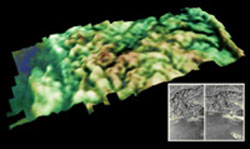NASA’s Cassini images reveal spectacular evidence of an active moon

Images from the European Space Agency’s Huygens probe descent imager/spectral radiometer side-looking imager and from the medium resolution imager, acquired after landing, were merged to produce this image.
Jets of fine, icy particles streaming from Saturn’s moon Enceladus were captured in recent images from NASA’s Cassini spacecraft. The images provide unambiguous visual evidence the moon is geologically active.
“For planetary explorers like us, there is little that can compare to the sighting of activity on another solar system body,” said Dr. Carolyn Porco, Cassini imaging team leader at the Space Science Institute in Boulder, Colo. “This has been a heart-stopper, and surely one of our most thrilling results.”
The Cassini images clearly show multiple jets emanating from the moon’s south polar region. Based on earlier data, scientists strongly suspected these jets arise from warm fractures in the region. The fractures, informally dubbed “tiger stripes,” are viewed essentially broadside in the new images.
The fainter, extended plume stretches at least 300 miles above the surface of Enceladus, which is only 300 miles wide. Cassini flew through the plume in July, when it passed a few hundred kilometers above the moon. During that flyby, Cassini’s instruments measured the plume’s constituent water vapor and icy particles.
Imaging team members analyzed images of Enceladus taken earlier this year at similar viewing angles. It was a rigorous effort to demonstrate earlier apparitions of the plumes, seen as far back as January, were in fact real and not due to imperfections in the camera.
The recent images were part of a sequence planned to confirm the presence of the plumes and examine them in finer detail. Imaging team member Dr. Andrew Ingersoll from the California Institute of Technology in Pasadena, said, “I think what we’re seeing are ice particles in jets of water vapor that emanate from pressurized vents. To form the particles and carry them aloft, the vapor must have a certain density, and that implies surprisingly warm temperatures for a cold body like Enceladus.”
Imaging scientists are comparing the new images to earlier Cassini data in hopes of arriving at a more detailed, three-dimensional picture of the plumes and understanding how activity has come about on such a small moon. They are not sure about the precise cause of the moon’s unexpected geologic vitality.
“In some ways, Enceladus resembles a huge comet,” said Dr. Torrence Johnson, imaging team member from NASA’s Jet Propulsion Laboratory (JPL) in Pasadena. “Only, in the case of Enceladus, the energy source for the geyser-like activity is believed to be due to internal heating by perhaps radioactivity and tides rather than the sunlight which causes cometary jets.” The new data also give yet another indication of how Enceladus keeps supplying material to Saturn’s gossamer E ring.
Media Contact
More Information:
http://www.nasa.govAll latest news from the category: Physics and Astronomy
This area deals with the fundamental laws and building blocks of nature and how they interact, the properties and the behavior of matter, and research into space and time and their structures.
innovations-report provides in-depth reports and articles on subjects such as astrophysics, laser technologies, nuclear, quantum, particle and solid-state physics, nanotechnologies, planetary research and findings (Mars, Venus) and developments related to the Hubble Telescope.
Newest articles

Silicon Carbide Innovation Alliance to drive industrial-scale semiconductor work
Known for its ability to withstand extreme environments and high voltages, silicon carbide (SiC) is a semiconducting material made up of silicon and carbon atoms arranged into crystals that is…

New SPECT/CT technique shows impressive biomarker identification
…offers increased access for prostate cancer patients. A novel SPECT/CT acquisition method can accurately detect radiopharmaceutical biodistribution in a convenient manner for prostate cancer patients, opening the door for more…

How 3D printers can give robots a soft touch
Soft skin coverings and touch sensors have emerged as a promising feature for robots that are both safer and more intuitive for human interaction, but they are expensive and difficult…





















